| Home | Timeline | Documents | Audio | Software | Links |
The Earlier Wheatstone Ledgers |
|||||
|
The Earlier Wheatstone Ledgers - A Bigger PictureWes WilliamsAlmost twenty years ago in December 2005, Robert Gaskins published a study on his website (www.concertina.com) that I had made on the four earliest surviving Wheatstone Ledgers detailing serial numbers and dates. This study was titled 'The Serial Number Muddle in Early Wheatstone Ledgers' (henceforth 'Muddle') is still available, and the information it contains and the conclusions reached remain valid. The main purpose was to demonstrate that Wheatstone serial numbers did not have a simple serial/date characteristic and that many almost continuous ranges of serial numbers occured over a number of years - so called 'range lines'. It was suggested that sub-contractors (those like Lachenal and Rock Chidley) were allocated a range of serial numbers to use on the completed instruments they produced. Perhaps a future project using sale prices from the early ledgers may be able to shed more light on these range lines. These 'Wayne' ledgers had been published on the internet by the Horniman Museum in Spring 2005, with the bulk of the work of scanning the ledgers and assembling the website being done by Robert Gaskins, who had made the later 'Dickinson' ledgers available in the same way in Spring 2003. I was lucky enough to have been involved in this project from the early days, so was not unfamiliar with the ledgers and their contents. The 'Muddle' was published as a 'Preliminary Version' and although I completed an extended version later, covering all pre-1870 dates, software problems prevented this being published. This document is derived from that later study, and has been extended to the end of 1913. All graphs presented are scatter-plots with points in black, and with serial numbers on the vertical axis and dates on the horizontal. The graph images are in GIF format to ensure that no data is lost. The graph below shows serial numbers versus dates for the first occurance of any serial number, between 1834 and 1913. There are 3 distinct areas of points, and these will be referred to as 'Wheatstone' (1834 to ~1870, serial numbers below 14000), 'Edward Chidley Senior' (1865 to 1893, serial numbers 18000 to ~22000) and 'Edward Chidley Junior' (1910 to 1913, serial numbers 25000 to ~26000) 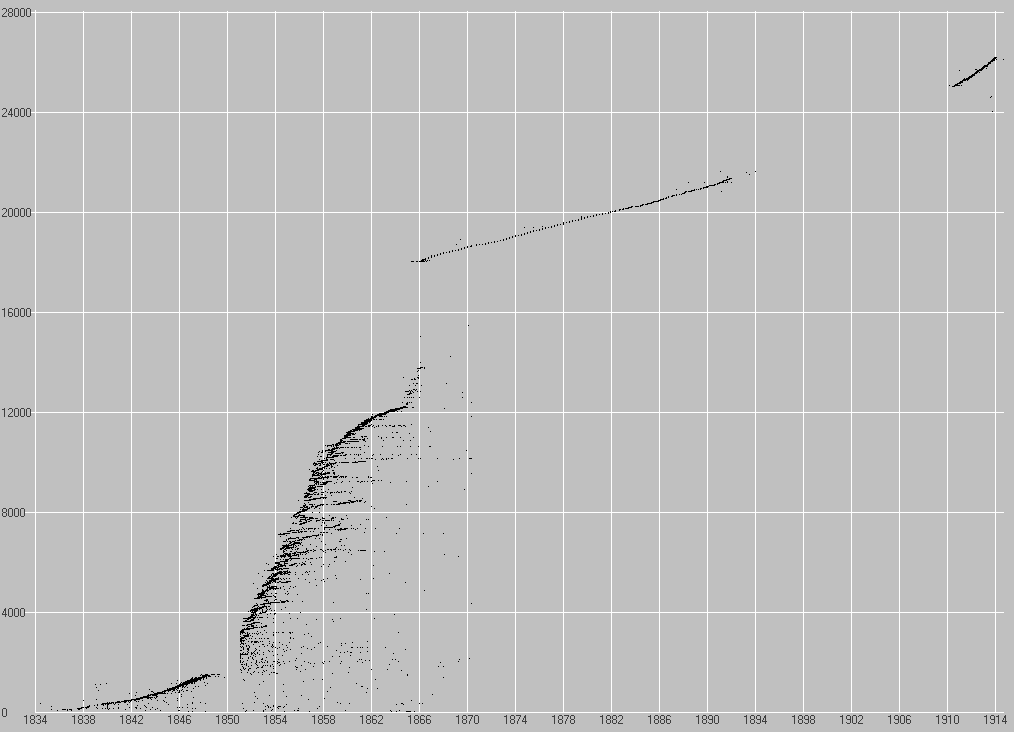
The 'Wheatstone' PeriodThis begins in 1834 and ends around 1870. The data is derived from ledgers C104a (serials 1 to 1500) and C1046 to C1053 (sales/hire/etc.). At the beginning of this period both Charles and William Wheatstone were involved in the company, but from around 1847 the company appears in many directory listings as 'William Wheatstone, Concertina Maker'. William died on 30 August 1862 without issue, so Charles probably became involved in arranging the continuation of the company. We know that Edward Chidley Senior (a close family relative of the Wheatstone brothers who had worked for Wheatstone) became involved with the company and began producing a range of Wheatstone concertinas in April 1865 starting with serial number 18000, and continued to produce them in this number range up to the end of ledger C1053 in May 1870. Ledger C1054 starts in March 1866, but contains only 18000 series serial numbers, so overlaps with data in ledger C1053. It is worth quoting from 'Muddle' about the accuracy of data: The graph below shows serial numbers versus dates for the first occurance of a serial number in the Wheatstone period 1834 to 1868. This is an extended version of the graph shown in 'Muddle'. 
This graph shows many 'range lines' between 1851 and 1859, although the general trend of rising instrument serials in this period is fairly linear on average. From the beginning of 1858 the yearly number of instruments starts to fall, probably due to Louis Lachenal marketing instruments under his own name, and the number of 'range lines' are smaller and less distinct. Louis Lachenal may no longer have had enough spare capacity to supply many complete instruments to Wheatstone, and his death in 1860 would further have affected the capability of his firm. By 1865 and the start of the Edward Chidley Senior period, there are no discernable trends in instrument numbers,and many gaps within the serial numbers recorded, although instruments with 18000 serial numbers upwards are also being produced. The next graph below shows a more detailed view of the first occurance of serial numbers between 6000 and 9500 from 1854 to 1861. 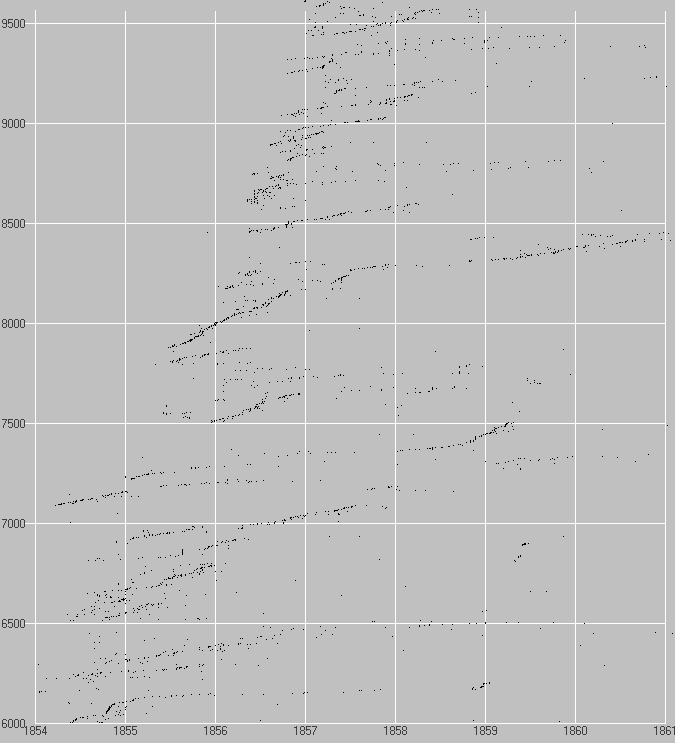
It can be seen for example, that serial numbers around 7100 upward start appearing near the beginning of 1854, but that serial numbers for around 7000 upward only start appearing half way through 1856. This shows how the muddle of serial numbers versus dates occurs. Since most of the ledgers in this period do not give any details of instrument characteristics - only the name of the buyer and the price paid - it is impossible to define the instruments any further. The 'Edward Chidley Senior' PeriodEdward Chidley Senior (b. 13 February 1830) and his older brother Rock (b. 12 April 1825) were close family relations of the Wheatstone brothers, and had both been employed by the company. Ledgers C1055 and C1056, payments for 1845-1846 and 1848-1849, contain entries for 'Chidley and brother' or 'Chidley'. At the beginning of 1845 'Chidley and brother' receive weekly payments of £1-16s (£1.80), rising to £2-2s (£2.10) in April,and by the end of the year £2-12s (£2.60). At the beginning of 1848 'Chidley' receives weekly payments at a rate of £3-10s (£3.50) for 7 days, but by February is also receiving extra payments 'as per book' suggesting he is doing external work for Wheatstones. Later regular payments made were substantial (at £6 to £8, second only to Lachenal at £24) suggesting that the Chidleys had established their own manufactory, and might have been a source of some of the 'range lines'. By 1850 Rock had left to form a concertina making company under his own name. Edward formed his own 'Edward Chidley' concertina company in Store Street, Bedford Square by 1861, so would have been an experienced choice to run the company in future. Although we do not know when he first became involved in the company after William Wheatstone's death, a new line of concertinas made by Edward, starting with a serial number of 18000, appear in ledger C1053 on 28 April 1865. Thirteen blank pages at the end of ledger C1053 could suggest that Edward had complete control of the company, and was the owner of it, by May 1870, which accords with dates suggested by other researchers. An 1870 directory listing for Edward's company (probably compiled in 1869) lists him at Wheatstone's premises in Conduit Street. The graph below shows a summary of serial numbers versus dates for the first occurance of a serial number in the 1864-1892 period from ledgers C1053 and C1054. The flatter portion on the graph at the start of the 18000 serial numbers comes from C1053 entries. C1054 is a production ledger organised by serial number which begins with monthly production figures, then changes to quarterly figures until 1882, and then continues with full dates. Details of each instrument are given. There are two notable dates within C1054; Model numbers rather than extended instrument descriptions first appear in January 1884 at serial number 20218 with model numbers 1 to 8 representing the standard range of treble concertinas, and the term 'Aeola' relating to a six sided version based on Model No 6 (48 key) or Model No.8 (56 key) first appears in September 1889 for 20974 to 20979. Four pages of loose notes inserted at the end of C1054 headed 'Concertina Nos. Wanted' extend some of the serial numbers to December 1893. Production throughout all this period can be seen to be fairly linear. 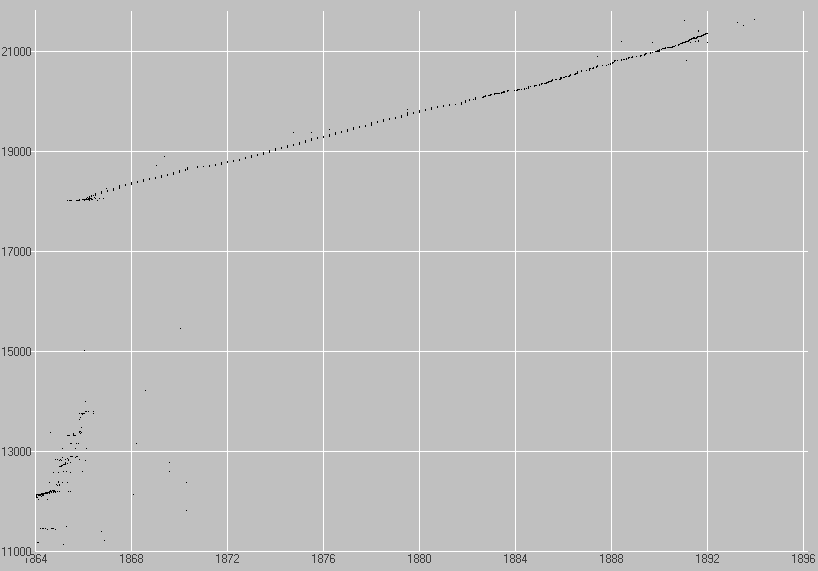
The 'Edward Chidley Junior' PeriodWhen Edward Chidley Senior died in 1899, the company passed on to his sons Edward and Percy. Edward took on the production side, while Percy seems to be more involved in the financial side. The brothers made major changes to the manufacture, re-introducing screwed reed plates and Anglo and Duet models, and the firm also moved to West Street in 1905, perhaps as a result of bequests in Edward Senior's will. Ledger SD01 covers the period 1910 to 1923, but only entries up to the end of 1913 have been transcribed for this study. This ledger shows a 'muddle of dates' as the ledger is in serial number order. When a graphical representation is plotted, effects similar to 'range-lines' can be observed. The small vertical lines (which are more apparent towards the end of 1911) may be either orders from dealers or manufacture for stock items, but the rest of the points appear to be dates from direct sales by Wheatstone & Co. There are a few outlying points apparent; these are from ledger entries where an instrument has been allocated a new serial number, but the original date of the instrument has been used. An example of this occurs in 1910 in ledger SD01 page 7 where the entry reads 'Dec 1 No. 21 Nickel Rosewood polished S.V. W.S. 25170' and a later addition reads 'altered to 25643'. 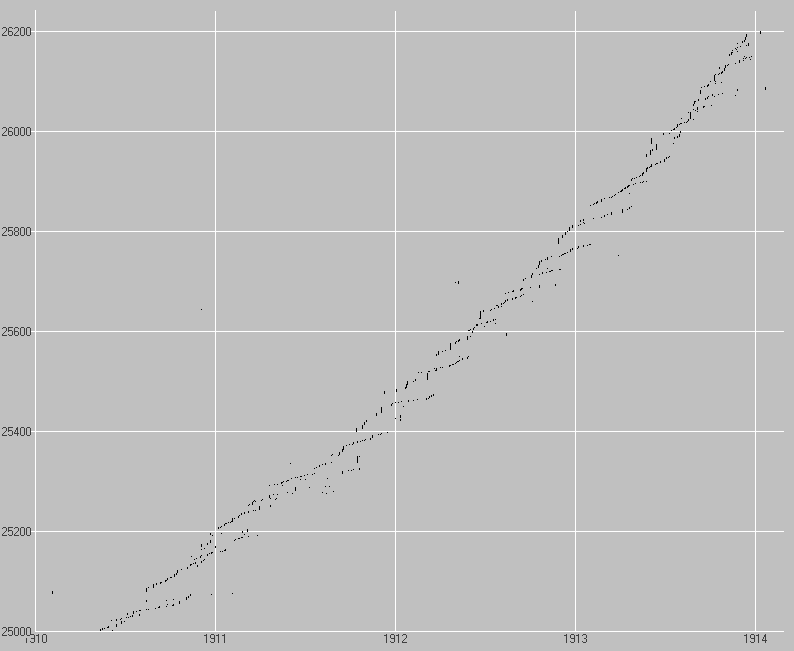
Serial Number Date Estimates For Missing LedgersThere are two areas where ledgers are missing - mid 1848 to 1851 and 1892 to 1910. The following two graphs show estimates for these two areas, and some guidance on how to use them. Mid 1848 to 1851 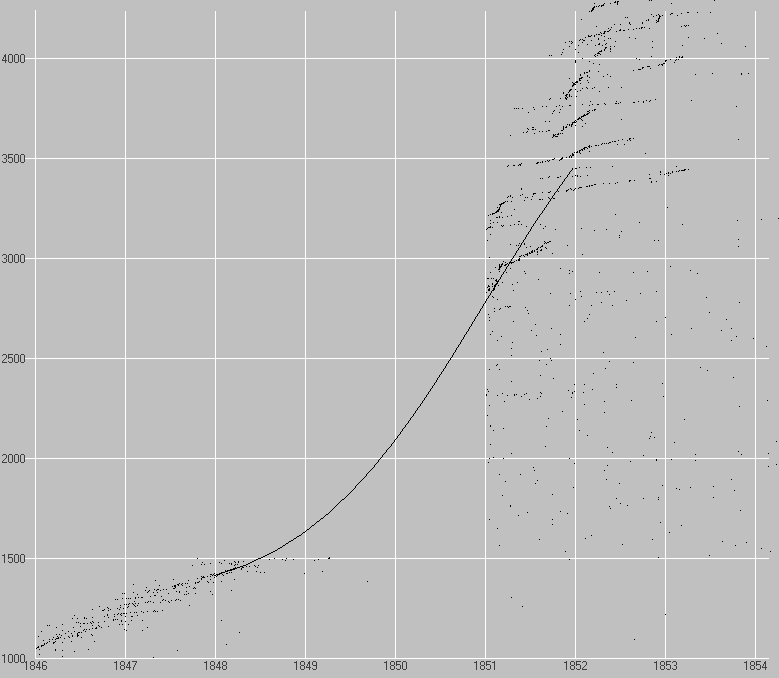
The graph above shows the missing mid 1848 to 1851 area, with an approximate estimate of serial numbers shown as a solid line. The plethora of range lines after 1851 make an estimate difficult, so the result is only an approximation. The estimate line has been drawn using a Bezier Spline. The first step in estimation is to check that serial number does not appear in the ledgers. This can be easily found by checking the Serial Number Lookup to Wheatstone Ledgers 1830s to 1890s. If the first date returned is 1851 or later, then this is likely to be a later date than the original date of an instrument, and the table below will give a better estimate of the original date. If no date is found the table below will give an estimate for the year of manufacture.
For comparison, Dates of Concertinas by Henry Minting (see
Further Resources at the end of this page) gives approximate figures of: 1892 to 1910 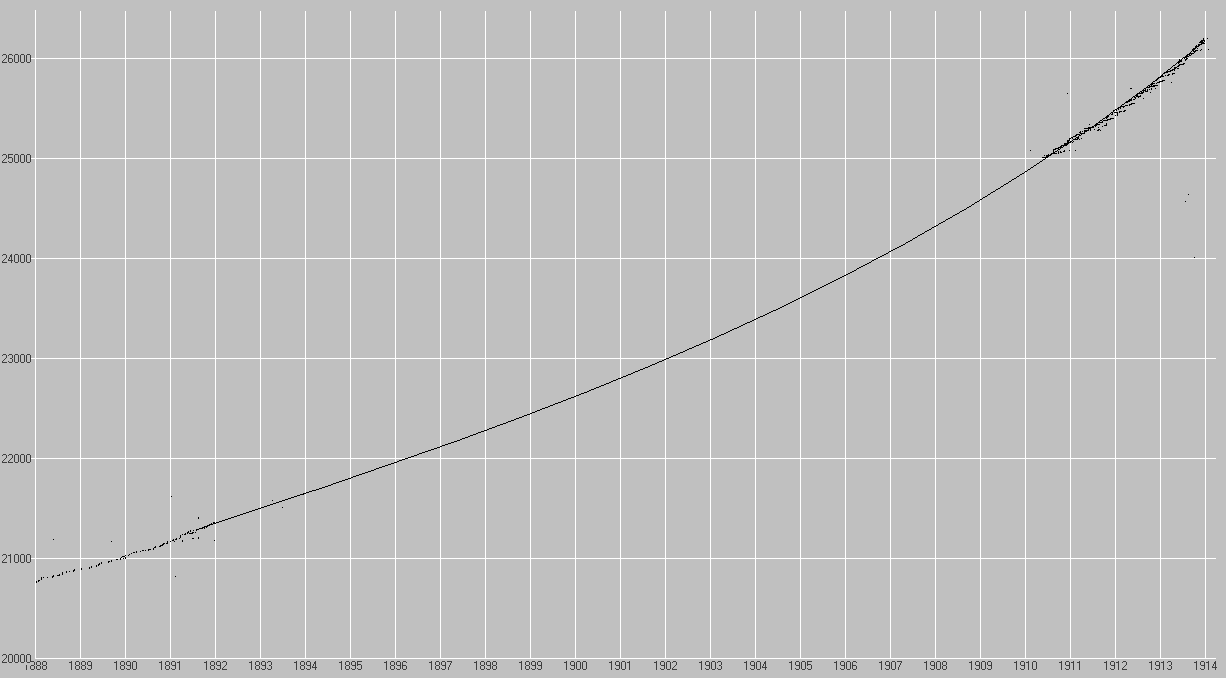
The graph above shows the missing 1892 to 1910 area, with a estimate of serial numbers shown as a solid line. The estimate line has been drawn using a Bezier Spline. The table below will give an estimate for the year of manufacture.
For comparison, Dates of Concertinas by Henry Minting (see Further
Resources at the end of this page) gives approximate figures I have
interpreted as:
Further Resources
The Wheatstone Ledgers may be viewed at
www.horniman.info
© wes williams November 2023. 
|

